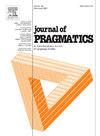一致的断言点头:认识论坚持的体现
IF 1.7
1区 文学
0 LANGUAGE & LINGUISTICS
引用次数: 0
摘要
基于点头的功能意义可能随其物理形式和执行而变化这一概念,这篇对话分析报告建立并扩展了我们对所谓的“断言点头”的探索,在这种语境中,它们与积极极性的话语共同出现——这里被称为“和谐的断言点头”——在自然发生的,多方英语对话中。我们主要关注出现这些节点的两种主要上下文:(1)伴随主张或断言时,以及(2)伴随问题时。在这里研究的案例中,话语伴随着断言性的点头——无论是主张、断言还是问题——通常出现在参与者之间的认知斗争时刻。在大多数情况下,这些斗争包括对手头问题的认知首要地位的争夺,或者通过在提出主张或断言时隐含地采用知识渊博的K+立场,或者通过质疑挑战另一个假设的K+立场。贯穿这些案例的是,在展开的互动谈判中,点头的说话者标志着认知参与程度提高的时刻——表明对自己立场的承诺和坚定。我们的研究结果有助于社会互动中的认识论和体现行为的研究,并挑战了点头与积极价值行为的常识性联系,揭示了通常被称为“点头”的行为远非单一的、无差别的行为。本文章由计算机程序翻译,如有差异,请以英文原文为准。
Concordant assertoric nods: Embodiment of epistemic insistence
Building on the notion that the functional significance of nods may vary with their physical form and execution, this conversation-analytic report builds on and extends our exploration of what we have termed “assertoric nods” to contexts in which they co-occur with utterances of positive polarity—referred to here as “concordant assertoric nods”—in naturally occurring, multi-party English conversation. We focus on two primary contexts in which these nods arise: (1) when accompanying a claim or assertion, and (2) when accompanying a question. In the cases examined here, utterances accompanied by an assertoric nod—whether a claim, assertion, or question—typically emerge during moments of epistemic struggle between participants. For the most part, these struggles involve contests for epistemic primacy over the issue at hand, either through the implicit adoption of a knowledgeable K+ stance when making a claim or assertion, or by challenging another's assumed K+ position through questioning. What holds across these cases is that the nodding speaker marks a moment of heightened epistemic engagement—demonstrating commitment and steadfastness toward their position—within the unfolding interactional negotiation. Our findings contribute to research on epistemics and embodied conduct in social interaction and challenge the common-sense association of head nodding with positively valenced actions, revealing that what is commonly referred to as “head nodding” is far from a single, undifferentiated action.
求助全文
通过发布文献求助,成功后即可免费获取论文全文。
去求助
来源期刊

Journal of Pragmatics
Multiple-
CiteScore
3.90
自引率
18.80%
发文量
219
期刊介绍:
Since 1977, the Journal of Pragmatics has provided a forum for bringing together a wide range of research in pragmatics, including cognitive pragmatics, corpus pragmatics, experimental pragmatics, historical pragmatics, interpersonal pragmatics, multimodal pragmatics, sociopragmatics, theoretical pragmatics and related fields. Our aim is to publish innovative pragmatic scholarship from all perspectives, which contributes to theories of how speakers produce and interpret language in different contexts drawing on attested data from a wide range of languages/cultures in different parts of the world. The Journal of Pragmatics also encourages work that uses attested language data to explore the relationship between pragmatics and neighbouring research areas such as semantics, discourse analysis, conversation analysis and ethnomethodology, interactional linguistics, sociolinguistics, linguistic anthropology, media studies, psychology, sociology, and the philosophy of language. Alongside full-length articles, discussion notes and book reviews, the journal welcomes proposals for high quality special issues in all areas of pragmatics which make a significant contribution to a topical or developing area at the cutting-edge of research.
 求助内容:
求助内容: 应助结果提醒方式:
应助结果提醒方式:


